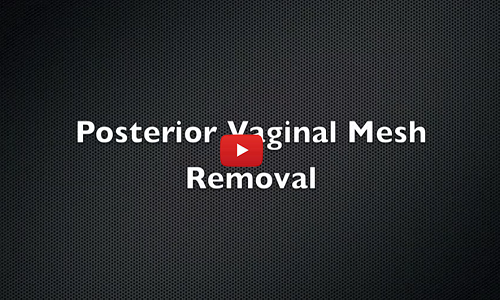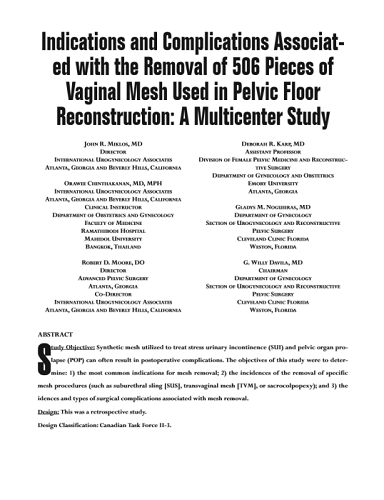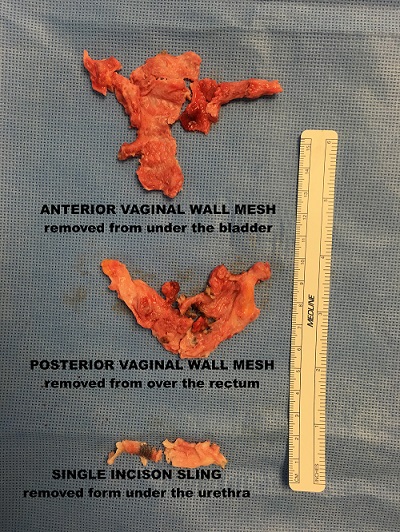WHAT ARE THE SIGNS AND SYMPTOMS OF FAILED MESH?
Patients can have immediate or delayed failed mesh results. The goal of the mesh is to support and keep the patient from having recurrent cystocele, rectocele, vaginal vault prolapses or stress urinary incontinence. The most obvious failure is the recurrence of the vaginal prolapse or incontinence.
However, after the surgery one may find that the patient has excellent support for any area treated with the mesh, but she presents with other problems such as:
Chronic Pain– is one of the most common & most devastating complications of transvaginal mesh surgery. This can be caused by nerve damage, mesh erosion into neighboring organs such as: bladder, urethra, rectum, small or large bowel or most commonly the vaginal skin or excessive scar tissue which can pull on nerves resulting in pain.
Painful sex – the mesh can cause painful intercourse for the patient and / or her partner. Again, the scar tissue can cause pain by tension on nerves or exposure, extrusion, or erosion of mesh.
Infection- which may result in tissue or organ wall infection which can manifest as a symptom of pain, fever, discharge.
Mesh exposure -transvaginal mesh can become exposed so one can see the mesh coming through the vaginal skin, but it does NOT protrude beyond the height of the skin., this can cause pain or painful intercourse for the patient and her partner as well as bleeding and infection.
Mesh extrusion – mesh is exposed through the skin but is protruding above or beyond the borders of the skin.
Mesh erosion – is like mesh exposure however instead of the mesh migrating or being seen on the outside i.e., as a disruption in the skin of the vagina one would see the mesh penetrating the inside of a neighboring organ such as the urethra, bladder, or rectum. When this happens common signs or symptoms include pain, bleeding, infection, painful intercourse or potentially blood in the urine or in the feces and pain during urination or defecation.
Urinary problems – may include complete urine retention, the inability to empty one’s bladder, urgency, frequency, overactive bladder, recurrent urinary tract infections or urinary incontinence. The mesh can cause urinary problems, such as urinary incontinence, urinary retention, and urinary tract infections.
If you are experiencing any of these signs or symptoms after undergoing transvaginal mesh surgery, it is important to consult with an experienced mesh removal surgeon or healthcare provider for proper evaluation and treatment. All too often patients are having mesh failures inappropriately evaluated or even treated. Failure to remove the mesh appropriately can lead to further complications and worsening conditions as well as making the remainder of the mesh even more difficult to find and remove in future surgery.
WHY CHOOSE MIKLOS & MOORE UROGYNECOLOGY TO END YOUR FAILED MESH PAIN?
Dr. Miklos is a highly experienced and skilled surgeon who specializes in the treatment of mesh complications. He has removed more than 1,000 pieces of mesh and has been removing mesh since 1994. Few surgeons in the world can make this claim. Dr. Miklos has a patient-centered approach to care and listens to the patient’s point of view which is not always supported by the scientific literature. He takes the time to thoroughly evaluate each patient’s unique situation and develop a personalized treatment plan and makes recommendations but allows each patient to make the final decision as to the surgery and technique. He truly believes that he makes the patient an informed consumer so she can make ultimately make the right decision to minimize or stop patients’ pain and suffering. Overall, choosing Dr. Miklos for your mesh complication surgery can provide you with the expert care and support you need to achieve the best possible outcome.
Dr. Miklos has:
EXPERIENCE -First and foremost at Miklos & Moore Urogynecology the doctors listen. They have been removing mesh since 1998 and have seen, treated, or removed just about every type of transvaginal mesh complication known to man. They have removed more than 1000 pieces of mesh with minimal complications and superior success. The largest USA paper written on mesh removal is a series of 506 pieces of mesh in 3.5 years and Dr. Miklos was responsible for removing 400 of the 506 pieces of mesh. (Figure 1)
EXPERTISE – They have treated patients from all over the world for mesh complications. They have produced award-winning videos which have gotten them international acclaim for their mesh-removing technique.
KNOWLEDGE – They are Rule 26 medical legal experts who understand the law and malpractice cases facing patients today. They are also leaders in the world on mesh complications as they have written some of the largest papers on mesh complications found in the worldwide literature.
RESULTS – Miklos & Moore Urogynecology have addressed and removed some of the most difficult transvaginal mesh devices made and inserted in the human body. Though no one can guarantee the success rate for fixing the patient’s symptoms, Dr Miklos can usually remove >95% of the mesh load > 90% of the time. He can totally remove the complete implant most of the time if the patient so desires or it is medically indicated.
Here at Miklos & Moore Urogynecology we have removed mesh from inside urethra, bladder, rectum and small bowel. We have repaired fistulas due to the mesh in the bladder, urethra, and the rectum. We have removed as many as 3 mesh slings in one patient and 4 mesh devices in another patient during one operation. (Figure 2) In selected cases, Dr Miklos can also offer reconstructive surgery to repair further prolapse or incontinence after the mesh removal.
RECOVERY TIME AFTER FAILED MESH REMOVAL SURGERY?
The recovery time after mesh complication surgery is directly dependent upon the patient’s complication and its severity, the approach to the surgical procedure utilized to place the mesh, the reconstruction of the vagina and its adjacent structures after removing the mesh as well as the approach to remove the mesh (via the vagina, groin, abdominal or laparoscopic.)
If a patient is removing a transvaginal mesh or sling and the surgeon only removes the vaginal portion of this mesh, most patients will spend one night in the hospital to recover and subsequently be released the next day. The patient is instructed to NOT have intercourse of do any heavy lifting or straining of the pelvic floor for 6 weeks. If the patient is having mesh removed through the abdomen (sacralcolpopexy or retropubic TVT sling) the recovery is also 6 weeks, however if she gets concurrent surgery to fix the vault prolapse or the potential urine leakage with cough the patient may resume normal activities in 12 weeks.

POSTERIOR VAGINAL MESH REMOVAL



